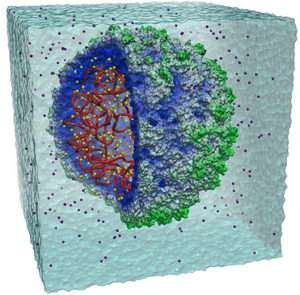Researchers simulate complete structure of virus鈥搊n computer

When Boeing and Airbus developed their latest aircraft, the companies鈥� engineers designed and tested them on a computer long before the planes were built. Biologists are catching on. They鈥檝e just completed the first computer simulation of an entire life form 鈥� a virus.
In their quest to study life, biologists apply engineering knowledge somewhat differently: They 鈥渞everse engineer鈥� life forms, test fly them in the computer, and see if they work in silico the way they do in vivo. This technique previously had been employed for small pieces of living cells, such as proteins, but not for an entire life form until now.
The accomplishment, performed by computational biologists at the University of Illinois at Urbana-Champaign and crystallographers at the University of California at Irvine, is detailed in the March issue of the journal Structure.
Deeper understanding of the mechanistic properties of viruses, the researchers say, could not only contribute to improvements in public health, but also in the creation of artificial nanomachines made of capsids 鈥� a small protein shell that contains a viral building plan, a genome, in the form of DNA or RNA.
Viruses are incredibly tiny and extremely primitive life forms that cause myriad diseases. Biologists often refer to them as particles rather than organisms. Viruses hijack a biological cell and make it produce many new viruses from a single original. They鈥檝e evolved elaborate mechanisms of cell infection, proliferation and departure from the host when it bursts from viral overcrowding.
For their first attempt to reverse engineer a life form in a computer program, computational biologists selected the satellite tobacco mosaic virus because of its simplicity and small size.
The satellite virus they chose is a spherical RNA sub-viral agent that is so small and simple that it can only proliferate in a cell already hijacked by a helper virus 鈥� in this case the tobacco mosaic virus that is a serious threat to tomato plants.
A computer program was used to reverse engineer the dynamics of all atoms making up the virus and a small drop of salt water surrounding it. The virus and water contain more than a million atoms altogether.
The necessary calculation was done at Illinois on one of the world鈥檚 largest and fastest computers operated by the National Center for Supercomputing Applications. The computer simulations provided an unprecedented view into the dynamics of the virus.
鈥淭he simulations followed the life of the satellite tobacco mosaic virus, but only for a very brief time,鈥� said co-author Peter Freddolino, a doctoral student in biophysics and computational biology at Illinois. 鈥淣evertheless, they elucidated the key physical properties of the viral particle as well as providing crucial information on its assembly.鈥�
It may take still a long time to simulate a dog wagging its tail in the computer, said co-author Klaus Schulten, Swanlund Professor of 麻豆淫院ics at Illinois. 鈥淏ut a big first step has been taken to 鈥榯est fly鈥� living organisms,鈥� he said. 鈥淣aturally, this step will assist modern medicine as we continue to learn more about how viruses live.鈥�
The computer simulations were carried out in Schulten鈥檚 Theoretical and Biophysics Group鈥檚 lab at the Beckman Institute for Avanced Science and Technology.
Other co-authors were Anton Arkhipov, a doctoral student in physics at Illinois, and Alexander McPherson, a professor of molecular biology and biochemistry, and research specialist Steven Larson, both at UC-Irvine.
Source: University of Illinois at Urbana-Champaign















